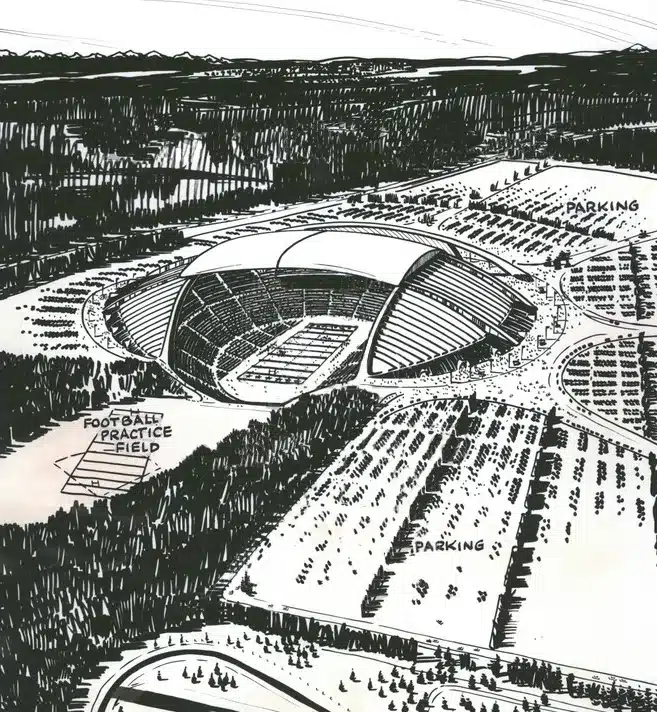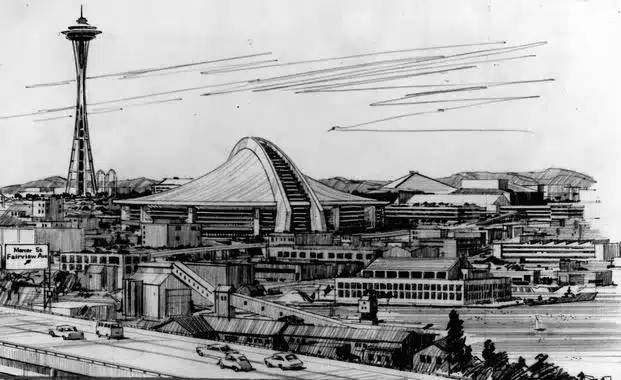In 1958 the Dodgers and Giants moved from New York to California and opened up the possibility of more professional sports teams on the West Coast. Seattle built an arena for the 1962 World’s Fair that would lure the NBA to town, with the Sonics beginning play in 1967.
All that was left for Seattle to become a major league city was to build a multi-purpose facility that could support both Major League Baseball and the NFL. Against this backdrop, the 1960s were a time of wild stadium proposals. Some were ridiculous, but there are some you can’t help but look and wonder what would have happened if they’d been built.
Let’s check out five of the most audacious stadium proposals that would have transformed Seattle.
1. Waterfront Stadium

Okay, this stadium proposal was pretty wild. But here’s what’s amazing: it almost happened! In fact, it was backed by the King County Commissioners ahead of a funding referendum and received support from 51.5 percent of voters. However, it didn’t pass because measures at that time in Seattle required a 60% supermajority.
The stadium would have sat on a floating platform on Elliott Bay with ferries being able to directly drop off groups of fans. There almost certainly would have been problems with this stadium, but it’s hard to argue that it would have also become one of the most iconic stadiums in Major League Baseball.
In the years that followed, Seattle was awarded an expansion franchise in 1967 that would become the Pilots. That team would play a single season in Seattle at Sick’s Stadium before relocating to Milwaukee. In the end, Sick’s Stadium was too poor to be even a temporary solution while the timetable for a new stadium in Seattle wasn’t set in stone. Voters in 1970 would reject a new stadium at Seattle Center (more on that in a bit). However, in late 1971 approval was given to construct a stadium in an industrial area south of downtown. That Stadium would become the Kingdome, but as you’ll see in this article, there were many other incredible ideas before the Kingdome was eventually selected.
2. Sonics Arena

Let’s just get this out of the way: Clay Bennett sucks. If you’re not familiar with him and the cast of characters that led to the Sonics leaving Seattle, here goes:
- Clay Bennett: The leader of the Oklahoma City group that bought the Sonics with the intent to move them.
- Howard Schultz: The founder of Starbucks who sold the Sonics to a group that clearly wanted to move them. The Sonics would be worth somewhere around $5 billion if located in Seattle today, but Schultz sold them for $350 million and managed to become a villain in his hometown at the same time. Quite the genius businessman he is.
- Aubrey McClendon: Another member of the ownership group that bought the Sonics. The less said about him, the better… But hell, let’s say more!
As noted, the group that bought the Sonics never really had any intention of keeping them in Seattle. Instead, they wanted to move them to Oklahoma City, which is now one of the worst markets in the NBA. Not surprisingly, the Thunder are now making noise about leaving Oklahoma City if they don’t get a publicly-funded arena.
And did I mention that McClendon almost drove his company into bankruptcy through a series of risk-filled projects in the years following moving the Sonics (The company would eventually declare bankruptcy in 2020)? He ultimately passed away after driving his car into a wall the day after a federal grand jury indictment.
Quite the cast of characters!
So, it’s at this point I should note that the ownership group proposed a pretty cool rendering for a Sonics Arena. It could have been built in Renton, or maybe Bellevue, but the point was it was never a serious proposal with Key Arena having undergone a massive renovation less than 15 years before.
3. Kent Stadium

I gotta be honest, Kent Stadium looks pretty cool. In fact, it looks like a retro version of AT&T Stadium, which is the home of the Dallas Cowboys today. The stadium was conceptualized as a rural (at the time!) stadium that could draw fans from both Seattle and Tacoma and fill an 80,000-seat stadium.
The reason Kent Stadium didn’t happen is that the city of Seattle was actively looking for a stadium in Seattle and Kent Stadium would have been privately funded. In the end, support for a stadium went to proposals backed by the city of Seattle.
But still, you can’t help but look at the early rendering of Kent Stadium and wonder if it could have become an incredible landmark today!
4. The Seattle Center Dome

Today, most of Seattle’s big events are hosted in SoDo, where Lumen Field and T-Mobile Park are located.
However, that wasn’t the first plan from the city. Instead, most original plans for a mixed-used stadium were focused around Seattle Center. If these plans would have come to pass, the Mariners and Seahawks today would play next to Climate Pledge Arena, where the Kraken and a potential future NBA team play.
However, in 1970 voters rejected a proposal to build Seattle’s modern stadium in Seattle Center, which led the City Council to approve a new site off King Street where Lumen Field sits today.
5. Seattle Dome Concepts

We end our list noting that there were a number of concepts before the Kingdome was selected. We can see one of the more striking concepts above. Most of these concepts never got past a model, but a few saw serious consideration. One even included a wooden roof. Several others were open-air.
Incredibly, aside from Wrigley and Fenway Park, there are no baseball stadiums that predate the planning for Seattle’s first baseball park. The third oldest baseball stadium is Dodgers Stadium in LA, which opened in 1962. Most stadiums today were built in a retro boom that started in 1992.
This is to say, while it’s fun to imagine what could have been with all these stadium proposals, the likely odds are that anything that was built would have been torn down.

